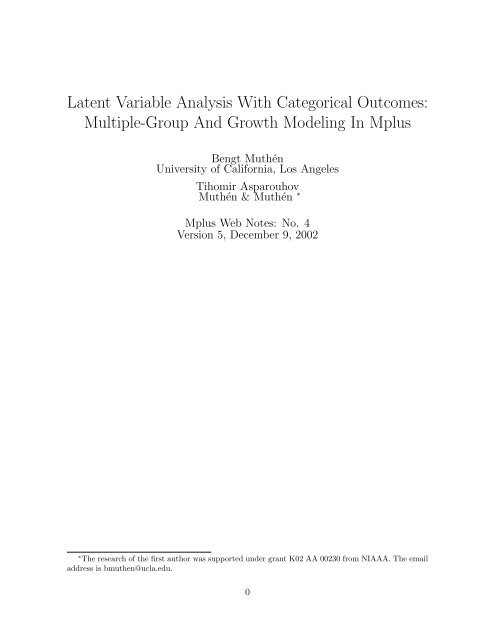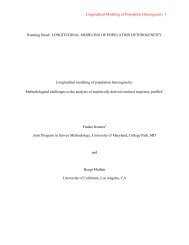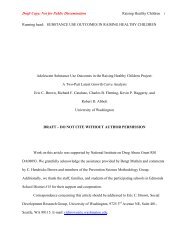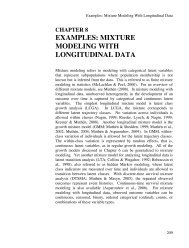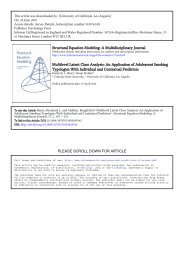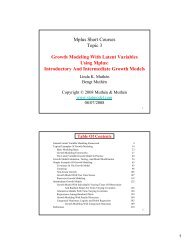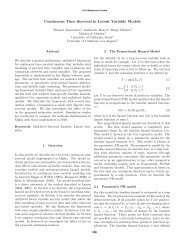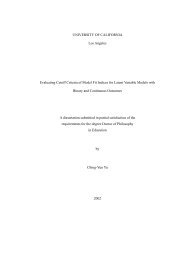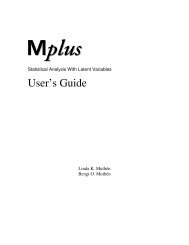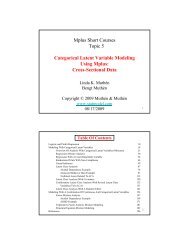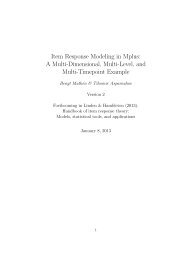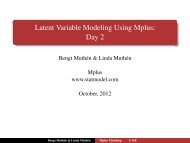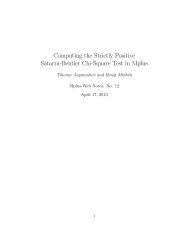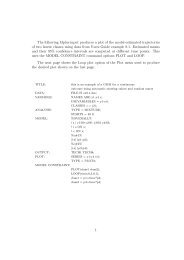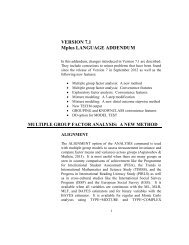Latent Variable Analysis With Categorical Outcomes ... - Mplus
Latent Variable Analysis With Categorical Outcomes ... - Mplus
Latent Variable Analysis With Categorical Outcomes ... - Mplus
Create successful ePaper yourself
Turn your PDF publications into a flip-book with our unique Google optimized e-Paper software.
<strong>Latent</strong> <strong>Variable</strong> <strong>Analysis</strong> <strong>With</strong> <strong>Categorical</strong> <strong>Outcomes</strong>:<br />
Multiple-Group And Growth Modeling In <strong>Mplus</strong><br />
Bengt Muthén<br />
University of California, Los Angeles<br />
Tihomir Asparouhov<br />
Muthén & Muthén ∗<br />
<strong>Mplus</strong> Web Notes: No. 4<br />
Version 5, December 9, 2002<br />
∗ The research of the first author was supported under grant K02 AA 00230 from NIAAA. The email<br />
address is bmuthen@ucla.edu.<br />
0
Abstract<br />
This note describes latent variable modeling with categorical outcomes in several<br />
groups and for longitudinal data. Different parameterizations are discussed as well as issues<br />
of identification. A comparison is made between formulating the modeling in terms<br />
of conditional probabilities versus using a latent response variable formulation. Two<br />
parameterizations used in <strong>Mplus</strong> are described, including a new parameterization introduced<br />
in Version 2.1, May 2002. Differences between binary outcomes and polytomous<br />
outcomes are discussed. The LISREL approach is also presented and compared to the<br />
<strong>Mplus</strong> approaches. It is shown that the <strong>Mplus</strong> approach avoids the LISREL restriction<br />
of across-group or across-time invariance of all thresholds parameters, making it possible<br />
to study (partial) non invariance also in the thresholds. The techniques are illustrated<br />
by factor analysis of antisocial behavior items and by Monte Carlo simulation examples<br />
of multiple-group factor analysis and growth modeling, showing good chi-square testing<br />
and estimation performance at rather low sample sizes.<br />
1
1 Introduction<br />
This note contains a technical discussion of parameterization and modeling in latent<br />
variable analysis of binary and ordered polytomous outcomes. Multiple-group and longitudinal<br />
settings are discussed together because they have analogous considerations<br />
regarding invariance and noninvariance of parameters. Two <strong>Mplus</strong> parameterizations<br />
are presented. A new approach introduced recently in <strong>Mplus</strong> allows for invariance testing<br />
of residual variances. The LISREL approach to multiple-group and longitudinal<br />
modeling is also presented and compared to the <strong>Mplus</strong> approaches. For technical references,<br />
see Muthén (1979, 1983, 1984, 1996), Muthén and Christofferson (1981), and<br />
Technical Appendix 2 of the <strong>Mplus</strong> User’s Guide (Muthén & Muthén, 1998-2002).<br />
Section 2 presents single-group cross-sectional modeling. Section 3 discusses an example,<br />
analyzing a factor model for antisocial behavior items. Section 4 presents the<br />
<strong>Mplus</strong> approach for multiple-group modeling. Section 5 extends the analysis of the<br />
antisocial behavior items to a gender comparison. Section 6 presents <strong>Mplus</strong> growth<br />
modeling. Section 7 presents the LISREL approach to multiple-group and growth modeling<br />
and Section 8 compares <strong>Mplus</strong> and LISREL approaches. Section 9 presents Monte<br />
Carlo simulation examples using <strong>Mplus</strong> for multiple-group and growth modeling.<br />
2 Parameterization In Single-Group, Cross-Sectional<br />
Studies<br />
<strong>Latent</strong> variable models for categorical outcomes can be presented in two ways, directly<br />
postulating a conditional probability model or deriving a conditional probability model<br />
from a linear model for latent response variables, where the observed outcomes are<br />
obtained by categorizing the latent response variables. It is shown that the two formulations<br />
give equivalent results. The discussion clarifies that the latent response variables<br />
are a convenient conceptualization, but that it is not necessary that the data have been<br />
generated by categorizing latent response variables.<br />
Below, the univariate and bivariate probability expressions are considered. For simplicity,<br />
a factor model with a single factor η is considered.<br />
2.1 Conditional Probability (CP) Formulation<br />
Consider an ordered polytomous y i variable with categories c = 0, 1, 2, . . . , C − 1 for<br />
individual i. Consider the standard proportional-odds model (Agresti, 1990, pp. 322-<br />
324), expressing the probability of being in one of the highest categories,<br />
P (y i ≥ c|η i ) = F [α c + β η i ], (1)<br />
2
where F is typically chosen as a normal or logistic distribution function (cf. Muthén<br />
& Muthén, 1998-2002; Technical Appendix 1). This formulation includes a binary y<br />
with only one α parameter. <strong>With</strong> a polytomous y, the model assumes parallel probability<br />
curves for the events y ≥ c, i.e. only intercepts α change over those probability<br />
expressions, not the slope β.<br />
Item Response Theory uses an equivalent conditional probability formulation written<br />
slightly differently,<br />
P (y i ≥ c|η i ) = F [a (η i − b c )], (2)<br />
where a is called the item discrimination and b c the item difficulty.<br />
The marginal distribution for y is obtained by integrating (1) over η, typically using<br />
a normality assumption for η.<br />
Bivariate counterparts to the conditional probability expression (1) introduces no<br />
further modeling issue because the y responses are assumed conditionally independent<br />
given η. Bivariate marginal probabilities, not conditioning on η, are again obtained by<br />
integrating over η using a normality assumption.<br />
2.2 <strong>Latent</strong> Response <strong>Variable</strong> (LRV) Formulation<br />
The LRV formulation considers a continuous latent response variable y ∗ that expresses<br />
the amount of understanding, attitude, or illness required to respond in a certain category.<br />
This acknowledges that a more fine-grained measurement could have been attempted.<br />
Consider for simplicity the 1-factor model for the continuous latent response<br />
variable y ∗ i for individual i,<br />
y ∗ i = ν + λ η i + ɛ i , (3)<br />
where ν is an intercept parameter, λ is a factor loading, η is a factor variable, and ɛ is<br />
a residual. The expectation and variance of y ∗ are<br />
µ ∗ = ν + λ α, (4)<br />
σ ∗ = λ 2 ψ + θ, (5)<br />
where α is the mean of η, ψ is the variance of η, and θ is the variance of the residual<br />
ɛ. Here, y ∗ is related to the observed ordered polytomous variable y via threshold<br />
parameters τ as<br />
y = c, if τ c < y ∗ ≤ τ c+1 (6)<br />
for categories c = 0, 1, 2, . . . , C − 1, where τ 0 = −∞, τ C = ∞. This leads to the<br />
conditional probability expression,<br />
P (y ≥ c|η) = F [−(τ c − ν − λ η) θ −1/2 ], (7)<br />
where F is typically chosen as a normal or logistic distribution function depending on<br />
the distributional assumption for ɛ.<br />
3
Consider the standardization E(η) = α = 0 so that µ ∗ = ν. Because y ∗ is a latent<br />
variable, its metric is not determined. It is therefore common to standardize to ν = 0<br />
and σ ∗ = 1. This may be viewed as θ not being a free parameter to be estimated, but a<br />
parameter that is obtained as the remainder<br />
θ = 1 − λ 2 ψ. (8)<br />
This standardization results in one particular metric for the τ and λ parameters of (7),<br />
but other metrics are also possible and have the same fit to data. Defining the scaling<br />
factor ∆ corresponding to the inverted latent response variable standard deviation<br />
∆ = 1/ √ σ ∗ , (9)<br />
one obtains a more general form of (8) where the scaling factor ∆ can be fixed at other<br />
values than one, resulting in<br />
θ = ∆ −2 − λ 2 ψ. (10)<br />
Standardizing to θ = 1 instead of σ ∗ = 1,<br />
which gives yet another metric for the τ and λ parameters.<br />
√<br />
∆ = 1/ λ 2 ψ + 1, (11)<br />
Given a uni- and bi-variate normality assumption for the y ∗ variables, the LRV<br />
formulation leads to the univariate and bivariate marginal probability expressions in the<br />
binary case<br />
∫ ∞<br />
P (y j = 1) = φ 1 (y ∗<br />
∆ j (τ j −µ ∗ j ) j ) dyj ∗ , (12)<br />
and<br />
∫ ∞ ∫ ∞<br />
P (y j = 1, y k = 1) =<br />
φ 2 (y ∗<br />
∆ j (τ j −µ ∗ j ) ∆ k (τ k −µ ∗ k ) j , yk) ∗ dyk ∗ dyj ∗ , (13)<br />
where φ 1 denotes a univariate standard normal density, φ 2 denotes a bivariate normal<br />
density with unit variances, zero means, and correlation coefficient,<br />
Corr(y ∗ j , y ∗ k) = ∆ j σ ∗ jk ∆ k , (14)<br />
where σ ∗ jk is the covariance between the two latent response variables y ∗ j and y ∗ k,<br />
Cov(y ∗ j , y ∗ k) = λ j ψ λ k . (15)<br />
2.2.1 LRV Model Identification<br />
From an identification point of view, it is important to note that only standardized<br />
quantities enter the probability expressions of (12) and (13) in that both the integration<br />
limits and the correlation have been scaled by ∆. From these two expressions the<br />
identification status of the model can be determined (cf Muthén, 1979). LRV models<br />
4
that are not identified in terms of uni- and bi-variate probabilities are not identified when<br />
also using higher-order terms. This is a function of the model and holds irrespective of<br />
estimation method. To see this, consider a multivariate normal y ∗ which is N(µ, Σ) and<br />
has threshold vector τ . The same y distribution is obtained considering ∆ y ∗ , which<br />
is N(∆ µ, ∆ Σ ∆), with thresholds ∆ τ . This implies that the maximum number of<br />
parameters that can be identified is p(p − 1)/2 + r, where p is the number of variables<br />
and r is the total number of thresholds summed over all variables. <strong>With</strong> multiple groups,<br />
this number of parameters is multiplied by the number of groups.<br />
In the standardization µ ∗ = 0, σ ∗ = 1, (12) shows that τ is identified as the corresponding<br />
z score. Given the threshold parameters, (13) shows the identification of the<br />
correlation coefficient. In line with factor analysis for continuous outcomes, fixing one λ<br />
to one, the remaining parameters λ and ψ are identified in terms of these correlations.<br />
It may be noted that even when the loadings λ are held equal or fixed for all items, as<br />
when testing equality of loadings across items, the residual variances θ are not separately<br />
identifiable. This is seen from (14) and (15). A change in a θ value can be absorbed in<br />
the factor variance ψ to give the same correlation.<br />
2.3 Comparison Of The Two Formulations<br />
It is clear from (1), (7), and (8) that the CP and LRV formulations are equivalent in<br />
terms of relating y and η to each other, with parameters related as<br />
or using the IRT parameterization,<br />
α c = −τ c<br />
√ , (16)<br />
θ<br />
β = λ √<br />
θ<br />
, (17)<br />
b c = τ c<br />
λ , (18)<br />
a = λ √<br />
θ<br />
. (19)<br />
It is seen from (17) and (19) that an increased residual variance θ gives rise to a flatter<br />
conditional probability curve and therefore attenuates the strength of the relationship<br />
between y and η. It is clear, however, that (in a single-group analysis) θ is not separately<br />
identifiable from the other parameters, motivating a standardization such as (8). Note<br />
that if the standardization of (8) is used, the degree of attenuation depends both on the<br />
loading λ and the factor variance ψ. For related discussions, see e.g. Muthén (1979),<br />
Muthén (1988), and Muthén, Kao and Burstein (1991). IRT estimates are obtained<br />
from the <strong>Mplus</strong> solution by using the transformation shown in (18) and (19). Standard<br />
errors can be obtained via the Delta method (see MacIntosh & Hashim, 2000).<br />
5
A researcher may take two different viewpoints in terms of modeling, (A) focusing<br />
on the CP formulation and its parameters α and β (or b and a) without introducing<br />
y ∗ , or (B) focusing on the LRV formulation and its parameters τ c , ν, λ, ψ, and θ. The<br />
two viewpoints have somewhat different consequences in multiple-group and longitudinal<br />
analysis.<br />
Under (A), the researcher is only interested in relating y to η and the α and β (b and<br />
a) parameters of the CP formulation are the only ones relevant. The CP model may be<br />
derived via the LRV formulation using y ∗ and related parameters, but this is only used<br />
as a pedagogical vehicle to motivate the CP formulation and only the resultant (16),<br />
(17) (or (18), (19)) functions of the LRV parameters are relevant.<br />
Under (B), the researcher believes that the LRV formulation has actually generated<br />
the data, so that y ∗ is a substantively meaningful variable and all the LRV parameters<br />
are in principle meaningful to the extent that they can be identified.<br />
2.4 Factor <strong>Analysis</strong> with Covariates<br />
The modeling discussed above can be extended to analysis with covariates (cf Muthén,<br />
1979, 1989). The covariates may influence the factors, and therefore the indicators<br />
indirectly, or may influence the indicators directly. Both the CP and LRV formulations<br />
can be used to describe such modeling. Using the LRV formulation, the model in (3) is<br />
extended as<br />
y ∗ i = ν + λ η i + κ x i + ɛ i , (20)<br />
where κ is the direct effect of the covariate x. In addition, the factor is related to x as<br />
η i = γ x i + ζ i . (21)<br />
Using the CP formulation, it follows for a binary item that<br />
P (y i = 1|η i , x i ) = F [−(τ − λ η i − κ x i )θ −1/2 ], (22)<br />
so that τ − κ x i can be seen as a new threshold value for the item, a threshold that<br />
varies across x values. This implies that the inclusion of direct effects can be used to<br />
study item bias, or differential item functioning (DIF), with respect to covariates, e.g.<br />
dummy covariates representing groups. If the direct effect is significant, the item shows<br />
DIF. This approach has been used in a variety of substantive applications, e.g. Gallo,<br />
Anthony and Muthén (1994) and Muthén, Tam, Muthén, Stolzenberg and Hollis (1993).<br />
This approach to studying DIF is a useful first, exploratory step in investigating<br />
across-group noninvariance of items. Although the DIF only concerns the threshold<br />
parameters, an item showing threshold DIF may also show noninvariance with respect<br />
to loadings. The approach consists of two steps. First, a model without any direct<br />
effects (κ = 0) is estimated. ”Modification indices” are studied to check the need for<br />
6
including direct effects (in the current <strong>Mplus</strong> version, first-order derivatives obtained by<br />
TECH2 can be used for this purpose 1 ).<br />
3 Factor <strong>Analysis</strong> of Antisocial Behavior<br />
The <strong>Mplus</strong> Web Note section (see www.statmodel.com) for this web note (<strong>Mplus</strong> Web<br />
Note #4) contains data on antisocial behavior items from the National Longitudinal<br />
Survey of Youth (NLSY). NLSY contains 17 antisocial behavior (ASB) items collected<br />
in 1980 when respondents were between the ages 16 and 23. The ASB items assessed<br />
the frequency of various behaviors during the last year. A sample of 7, 326 respondents<br />
is analyzed. Due to a very low proportion of the high-frequency category, the items are<br />
dichotomized as 0/1 with 0 representing never in the last year.<br />
The exploratory factor analysis output in the <strong>Mplus</strong> Web Note section shows that<br />
at least 3 factors are clearly defined. Here, the analysis will focus on one of the factors<br />
for simplicity. This is the third factor in the 3-factor solution and may be labelled as<br />
property offense, being measured well by the 8 items: property, shoplift, stealing less<br />
than 50 dollars, stealing more than 50 dollars, conning someone, auto theft, breaking<br />
into a building, and stealing goods.<br />
The confirmatory factor analysis output in the <strong>Mplus</strong> Web Note section shows the<br />
results from a 1-factor model for the 8 property offense items. The model appears to<br />
fit the data well. The con and auto items have the lowest loadings. In IRT terms, (19)<br />
shows that this also implies that these two items have the lowest item discrimination<br />
values.<br />
The MIMIC output in the <strong>Mplus</strong> Web Note section shows a factor analysis of the 8<br />
items using gender as a covariate (male = 0, female = 1). It is seen that females have a<br />
lower factor value than males (γ < 0 in (21)). The model may, however, be misspecified<br />
due to gender non-invariance of items. The largest modification index is for the item<br />
shoplift (−0.037).<br />
Letting the gender covariate directly influence the shoplift item improves the model<br />
fit and gives a significant direct effect (κ = 0.360 in (20) and (22)). For females the<br />
shoplift item has a lower threshold τ − κ in (22), which implies that compared to males,<br />
the female conditional probability curve of (22) is shifted to the left. The probability<br />
curves can be computed 2 and plotted for different factor values η. The interpretation<br />
is that for given property offense factor value, females are more likely to admit to the<br />
shoplift item than males.<br />
1 Note that these modification indices are not scale free, so that values cannot be compared across<br />
covariates in different scale, only across items for a given covariate.<br />
2 In the Delta parameterization, the residual variance θ of (22) is obtained from the R 2 section of<br />
the output, 0.492. In <strong>Mplus</strong>, the function F is the standard normal distribution function which can be<br />
looked up in a table.<br />
7
The gender non-invariance will be further explored in multiple-group analysis below.<br />
The multiple-group analysis allows for more flexibility in representing noninvariance of<br />
items, not only with respect to thresholds, but also with respect to loadings and residual<br />
variances.<br />
4 The <strong>Mplus</strong> Approach To Multiple-Group Modeling<br />
This section discusses the Delta and Theta multiple-group parameterizations in <strong>Mplus</strong>,<br />
followed by identification issues.<br />
Considering multiple-group analysis using the LRV formulation of (3) - (5) it is important<br />
to not standardize all groups to unit y ∗ variance since that would hide the<br />
across-group variation in y ∗ variance due to across-group variation in λ, ψ, and θ. The<br />
CP formulation of (1) also benefits from a more flexible, analogous parameterization<br />
in the case of multiple groups as suggested by the scaling factor 1/ √ θ in (16), (17).<br />
Adding this scaling factor, gives a generalized probit model. Although the y ∗ variance,<br />
or the residual variance θ, is not separately identified in a single group, variance differences<br />
across groups are identifiable given threshold and loading invariance and this more<br />
flexible parameterization can benefit the analysis.<br />
In <strong>Mplus</strong> this more flexible parameterization is handled in two alternative parameterizations,<br />
using a ”Delta approach” or using a ”Theta approach”. In both approaches,<br />
ν in (4) is standardized at 0 (inclusion of ν will be discussed further below).<br />
4.1 The Delta Approach<br />
In the Delta approach (cf. the <strong>Mplus</strong> User’s Guide, page 347; Muthén & Muthén,<br />
1998-2002), consider the scaling factor parameter ∆ g for group g, where<br />
∆ −2<br />
g = σ ∗ g, (23)<br />
i.e. ∆ g is the inverted standard deviation for y ∗ in group g. For two y ∗ variables j and<br />
k, the Delta approach considers the correlation in group g,<br />
Corr(y ∗ gj, y ∗ gk) = ∆ gj σ ∗ gjk ∆ gk , (24)<br />
where σ ∗ gjk is the covariance between the two latent response variables, σ ∗ gjk = λ gj ψ g λ gk .<br />
This implies that although correlations between the latent response variables are considered,<br />
the across-group variation in λ, ψ, and θ is captured through the corresponding<br />
across-group variation in ∆ g . This avoids the well-known problem of analyzing correlations<br />
when considering models that are not scale free.<br />
8
In the Delta approach, θ is not a parameter in the optimization but is obtained as a<br />
remainder<br />
θ g = ∆ −2<br />
g − λ 2 g ψ g , (25)<br />
resulting in (8) for the reference group if ∆ g = 1. The Delta approach has been found<br />
to have some advantages over the Theta approach in model estimation. The Delta approach,<br />
however, has the disadvantage that across-group differences in the scaling factors<br />
∆ g has three potential sources that are not distinguished: differences in λ; differences<br />
in ψ; and differences in θ. This disadvantage is avoided in the Theta approach given<br />
below. The Delta parameterization builds on the notion that, drawing on continuousoutcome<br />
experiences, residual variances are seldom invariant, and therefore a separate<br />
test of this is often less central. What is central for across-group factor comparisons is<br />
that thresholds and loadings are invariant to a sufficient degree.<br />
4.2 The Theta Approach<br />
The Theta approach was introduced in <strong>Mplus</strong> in Version 2.1, May 2002. In the Theta<br />
approach, the residual variance θ is a parameter in the optimization and the scaling<br />
factor ∆ g is obtained as a remainder,<br />
∆ −2<br />
g = λ 2 g ψ g + θ g . (26)<br />
This implies that the θ parameters enter into the correlation (24) via the ∆ g terms.<br />
The Theta approach standardizes to θ = 1 for all variables in a reference group, while<br />
estimating the θ parameters in the other groups. To test across-group equality of θ in a<br />
comparison group, θ is fixed at 1 in the comparison group as well.<br />
4.3 Multiple-Group Measurement Invariance, Identification, And<br />
Standardization Issues In <strong>Mplus</strong><br />
Consider for simplicity the case of binary outcomes. Consider first the case with full<br />
measurement invariance, i.e. that the threshold τ j and loading λ j for outcome j are<br />
the same in all groups. A reference group is chosen with y ∗ variances standardized to<br />
unity, ∆ g = 1 for all variables, letting ∆ g be estimated for the other groups. The<br />
Theta parameterization is analogous, standardizing residual variances to unity in the<br />
reference group and estimating them in other groups. The standardization of ν = 0 for<br />
all variables in all groups and the factor mean α = 0 in the reference group gives<br />
E(y ∗ ref) = 0, (27)<br />
E(y ∗ nonref) = λ α nonref . (28)<br />
The univariate probability expression (12) shows that the standardizations identify the<br />
thresholds for all variables in the reference group. <strong>With</strong> the usual factor analysis standardization<br />
of one loading fixed at unity, the reference group identifies the loadings as<br />
9
well as the factor variance. Consider a non-reference group. Here, the correlations (14)<br />
identify ∆ g . This is because the loadings and factor variance are already known from the<br />
reference group, so that the ∆ g play the role of loadings which are identified. Because<br />
(12) in the non-reference group identifies E(y ∗ nonref), this means that α nonref is identified<br />
in the non-reference group. This shows that all parameters are identified.<br />
It may be noted that the choice of scale standardization ∆ g = 1 (or choice of θ<br />
standardization) is arbitrary (cf the earlier section LRV Model Identification). In the<br />
single-factor model considered here, a change from the standardization ∆ g = 1 to ∆ g = c<br />
for all variables is absorbed into the parameters as (assuming the factor metric is set<br />
by one λ fixed at unity) τ c = c −1 τ, α c = c −1 α nonref , ψ c = c −2 ψ. The ratios of ∆ g<br />
across the groups remain the same. The chi-square test of model fit and the ratios of<br />
estimates to standard errors remain the same. If instead the factor metric is set by fixing<br />
ψ = 1, the change is absorbed as λ c = c −1 λ, with no change in α or ψ. In the Theta<br />
parameterization, changing from the θ = 1 standardization for all variables in a reference<br />
group to θ = c, results in the changes (assuming metric set as λ 1 = 1) ∆ gc = √ c ∆ g so<br />
that τ c = √ c τ, α c = √ c α, ψ c = c ψ. The ratios of θ in the groups remain the same and<br />
the chi-square test of model fit and the ratios of estimates to standard errors remain the<br />
same.<br />
Consider next binary outcomes where some outcomes do not have measurement invariance<br />
across groups. For such outcomes, it is not meaningul to compare y ∗ distributions<br />
across groups since the y ∗ ’s are in different metric with measurement noninvariance.<br />
For such outcomes, the scaling factors ∆ g can be fixed at unity since no across-group<br />
comparison is made and this is also necessary to avoid indeterminacies. Analogously, in<br />
the Theta parameterization, the residual variances are fixed at unity.<br />
Millsap and Tein (2002) develops a set of minimal across-group invariance restrictions<br />
on thresholds and other parameters that provides sufficient conditions for identification<br />
and compares multiple-group model testing using LISREL and <strong>Mplus</strong>. In the discussion<br />
above it is assumed that a considerably higher degree of invariance is present. To make<br />
meaningful comparisons of factor distributions across groups and across time points,<br />
a majority of the variables should have both threshold and loading invariance so that<br />
the factors not only are in the same metric technically, but so that it is also plausible<br />
that the variables measure factors with the same meaning in the different groups or<br />
at the different time points. As a baseline model, all thresholds and loadings may be<br />
held invariant, using model modification indices to relax these assumptions for variables<br />
where this does not fit the data well.<br />
5 Multiple-Group <strong>Analysis</strong> of Antisocial Behavior<br />
This section continues the analysis of the 8 property offense items from the ASB instrument<br />
in the NLSY. The shoplift item had been found noninvariant with respect<br />
to gender. The multiple-group output in the <strong>Mplus</strong> web note section considers several<br />
10
analyses, with and without item invariance across gender.<br />
First, invariance is assumed for all items with respect to thresholds and loadings,<br />
allowing residual variances to be different across the groups (using the Theta parameterization),<br />
or letting the scale factors be different across groups (using the Delta parameterization).<br />
The factor means and variances are allowed to vary across gender. It<br />
should be noted that the gender difference in the factor mean is now insignificant. The<br />
difference relative to the earlier significance finding using factor analysis with covariates<br />
is presumably due to the group-varying residual variances (scale factors in the Delta<br />
parameterization), or due to allowing gender differences in the factor variance.<br />
Next, threshold and loading noninvariance is allowed for the shoplift item. 3 It is seen<br />
that the model fit improves and that the shoplift thresholds and loadings are different<br />
across gender. For females the item has a higher loading and a lower threshold which<br />
implies that compared to males, the female conditional probability curve of (22) is steeper<br />
and shifted to the left. The probability curves can be computed 4 and plotted for different<br />
factor values η. The interpretation is that for given property offense factor value, females<br />
are more likely to admit to the shoplift item than males and the difference increases<br />
with increasing factor value. Note that the gender difference in the factor mean is now<br />
significant, whereas it was not in the invariance model. The misspecification of gender<br />
invariance for the shoplift item, for which females have a higher conditional probability,<br />
attenuated the higher male factor mean to the point of becoming insignificant.<br />
The Theta parameterization can be used to estimate a model with gender invariance<br />
of the residual variances for the items. Here, the male (the second group) residuals are<br />
fixed at unity, the value for females (the first group). Note that chi-square difference<br />
testing cannot be done using the default WLSMV estimator (Muthén, du Toit, & Spisic,<br />
1997), but that the WLS estimator will have to be used for such a purpose.<br />
6 Growth Modeling<br />
The longitudinal situation is analogous to the multiple-group situation, where the different<br />
time points correspond to the different groups. Muthén (1996) discusses details of<br />
growth modeling with binary outcomes, relates the <strong>Mplus</strong> approach to other approaches,<br />
and presents a Monte Carlo study using the weighted-least squares (WLS) estimator in<br />
<strong>Mplus</strong>. A linear probit growth model may be written as,<br />
y ∗ ti = η 0i + η 1i x t + ɛ ti , (29)<br />
3 Because the item is not invariant, the latent response variable is not in the same metric across the<br />
groups, so that its variance should not be compared across groups and cannot be identified. Due to<br />
this, the Delta parameterization fixes the scale factor for the item.<br />
4 In the Delta parameterization, the residual variance θ of (22) is obtained from the R 2 section of<br />
the output: 0.565 for females and 0.441 for males.<br />
11
where for example with T time points, x t = 0, 1, . . . , T − 1 so that η 0i is interpreted<br />
as an initial status (intercept) factor and η 1i is interpreted as a change (slope) factor.<br />
The model implies across-time differences in the individual values of yti<br />
∗ due to the<br />
slope factor. In the CP formulation, this LRV formulation translates to individuals’<br />
probabilities changing over time. To make the growth model meaningful, the yt<br />
∗ values<br />
need to be in the same metric across time. This is achieved with threshold invariance<br />
across time. While the mean of the slope factor is a free parameter, the mean of the<br />
intercept factor can be either (1) fixed at zero with free, across-time invariant thresholds,<br />
or (2) free with one threshold fixed at all time points.<br />
The mean and variance of y ∗ ti change over time as,<br />
E(y ∗ t ) = E(η 0 ) + E(η 1 ) x t , (30)<br />
V (y ∗ t ) = V (η 0 ) + V (η 1 ) x 2 t + 2 x t Cov(η 0 , η 1 ) + V (ɛ t ). (31)<br />
It is seen in (31) that the variance changes over time for three reasons: due to the slope<br />
variance, due to the intercept-slope covariance, and due to the time-specific variance<br />
for the residual. From experience with continuous outcomes, the variance of the timespecific<br />
residual ɛ ti is likely to vary across time. By analogy with the multiple-group<br />
case, this implies that while the scaling factors ∆ (in the Delta parameterization), or the<br />
residual variances (in the Theta parameterization), can be fixed at unity for a reference<br />
time point such as the first time point, they should be let free for remaining time points<br />
in order to not distort the growth model structure.<br />
Muthén (1996) points out that incorporating correlations among the ɛ residuals is<br />
straightforward when using the <strong>Mplus</strong> weighted least squares estimators, while harder<br />
with maximum-likelihood estimation. The y ∗ covariance between time points t and t ′ is<br />
V (η 0 ) + V (η 1 ) x t x t ′ + (x t + x t ′) Cov(η 0 , η 1 ) + Cov(ɛ t , ɛ t ′). (32)<br />
<strong>Mplus</strong> also allows growth modeling where the dependent variable in (29) is a factor<br />
measured with multiple categorical indicators at each time point (see also the <strong>Mplus</strong><br />
User’s Guide, Technical Appendix 7, page 366). This type of growth modeling with<br />
a factor analytic measurement model was proposed in Muthén (1983). Assuming for<br />
simplicity a model with a single factor η f , the measurement model for indicator j and<br />
the structural (growth) model at time point t are expressed as<br />
y ∗ jti = ν jt + λ jt η fti + ɛ jti , (33)<br />
η fti = η 0i + η 1i x t + ζ ti . (34)<br />
Typically, ν jt = 0 since location parameters are captured by the thresholds. As a baseline<br />
invariance assumption, λ jt = λ j for all t with corresponding threshold invariance. Here,<br />
the standardization of E(η 0 ) = 0 is used unless one threshold is fixed for one of the<br />
indicators. <strong>With</strong> multiple indicators it is possible to identify the growth model even<br />
with only partial measurement invariance of thresholds and loadings, including acrosstime<br />
changes in scaling factors or residual variances. The multiple-indicator case also<br />
makes it possible to identify time-specific factor residual variances V (ζ t ) in addition to<br />
the indicator- and time-specific residual variances V (ɛ jt ).<br />
12
7 The LISREL Approach<br />
7.1 Multiple-Group <strong>Analysis</strong><br />
The LISREL approach ultimately amounts to an analysis of mean vectors and covariance<br />
matrices for each group in line with a conventional continuous-outcome analysis. This<br />
gives an easy to understand approach, but it comes with the tradeoff of assuming acrossgroup<br />
invariance of thresholds.<br />
A technical description of the multiple-group analysis in LISREL is hard to find<br />
and the following is based on our understanding of notes by Jöreskog on the topic of<br />
analyzing ordinal variables, which have been posted on the SSI web site (see Jöreskog,<br />
2002). 5 Using PRELIS and LISREL, a 3-stage approach can be taken based on the<br />
LRV formulation (an alternative two-stage approach is also given below). In stage 1,<br />
the thresholds are estimated using the µ ∗ = 0, σ ∗ = 1 standardization in a single-group<br />
analysis of data from all groups. In stage 2, the thresholds are held fixed at their stage<br />
1 values and the estimation concerns the y ∗ µ ∗ , σ ∗ , and σ ∗ jk elements for all groups<br />
together with their asymptotic covariance matrices. Stage 3 then amounts to a regular<br />
multiple-group analysis for continuous outcomes based on these means, variances, and<br />
covariances. Because the stage 3 analysis is in a continuous-outcome framework, the<br />
µ ∗ = 0, σ ∗ = 1 standardization is not used in stage 3. Intercepts ν and residual<br />
variances θ can be identified. The conventional standardization of α = 0 in a reference<br />
group is used when imposing intercept (ν) invariance across groups.<br />
The LISREL stage 2 identification issues are important for understanding the procedure.<br />
Stage 2 does not use the standardization µ ∗ = 0, σ ∗ = 1 because these quantities<br />
are identified from univariate probabilities due to the thresholds being fixed, known.<br />
This can be seen as follows. More than two outcome categories are required (the binary<br />
case is discussed below). Consider a 3-category y variable (y = 0, 1, 2), where<br />
P (y = 2) =<br />
P (y = 1) =<br />
P (y = 0) =<br />
∫ ∞<br />
φ 1 (y ∗ ) dy ∗ , (35)<br />
∆(τ 2 −µ ∗ )<br />
∫ ∆(τ 2 −µ ∗ )<br />
∆(τ 1 −µ ∗ )<br />
∫ ∆(τ 2 −µ ∗ )<br />
−∞<br />
φ 1 (y ∗ ) dy ∗ , (36)<br />
φ 1 (y ∗ ) dy ∗ , (37)<br />
where ∆ = 1/ √ σ ∗ . Let the probits of the two integration limits be denoted p 2 and p 1 ,<br />
p j = ∆(τ j − µ ∗ ). (38)<br />
The three probabilities contain two independent pieces of information, which may be<br />
viewed in terms of the two probits. The ratio p 2 /p 1 eliminates ∆ which, given known<br />
5 We also acknowledge helpful communication with Roger Millsap.<br />
13
thresholds, identifies µ ∗ . Given the thresholds and µ ∗ , any of the probits can be used to<br />
identify ∆ and therefore σ ∗ .<br />
In principle, stage 1 and stage 2 can also be carried out in a single-step, multiplegroup<br />
analysis. Here, the thresholds are estimated, holding them equal across groups.<br />
The model has two indeterminacies per y ∗ variable. The standardization µ ∗ = 0, σ ∗ = 1<br />
can be imposed in a reference group. The probit expression (38) for the reference group<br />
identifies the thresholds. In the other groups, the p 2 /p 1 ratio eliminates ∆ and identifies<br />
µ ∗ for those groups. Given thresholds and µ ∗ , the σ ∗ variance is then identified in those<br />
other groups using any of the probits. Instead of the standardization µ ∗ = 0, σ ∗ = 1<br />
imposed in a reference group, the restrictions of average means over groups being zero<br />
and average variances being one may be used to eliminate the indeterminacies.<br />
7.1.1 <strong>Latent</strong> Response <strong>Variable</strong> Intercepts<br />
From the point of view of the CP formulation, the ν intercept parameters in (4) can be<br />
used to impose a less restrictive form of across-group invariance for the thresholds. This<br />
is clear from (7), where the τ c −ν term can have across-group invariance of the τ c ’s while<br />
across-group differences in the ν’s. Viewing κ g = τ c − ν g as the effective thresholds in<br />
the CP formulation, the κ g thresholds are not group invariant but allow a rigid ν g shift<br />
(maintaining the distance between them for a given variable) of all the thresholds for a<br />
given variable. This is another generalization of an ordered probit model and is used in<br />
the LISREL approach. From an LRV point of view, where the y ∗ variables are thought<br />
of as substantively meaningful, this is straightforward to interpret. The interpretation<br />
from a CP point of view is less compelling because it is hard to motivate why threshold<br />
non-invariance would take place in the form of a rigid shift. It seems more likely that<br />
threshold non-invariance occurs quite differently with respect to different thresholds for<br />
a variable.<br />
7.1.2 Binary Case<br />
The case where all outcomes are binary requires special treatment in the LISREL approach.<br />
In this case, there is only information on a single probit ∆(τ − µ ∗ ) per group.<br />
Even when holding thresholds invariant across groups, this does not identify both µ ∗<br />
and σ ∗ in all groups. In the LISREL approach this is handled by fixing σ ∗ = 1 in all<br />
groups, only allowing µ ∗ to vary across groups.<br />
7.2 Longitudinal <strong>Analysis</strong><br />
In line with the <strong>Mplus</strong> longitudinal section, no special consideration arise beyond those<br />
of multiple-group analysis.<br />
14
8 Comparing The <strong>Mplus</strong> And LISREL Approaches<br />
This section compares the parameterizations used in the <strong>Mplus</strong> and LISREL approaches<br />
and their consequences. While the focus is on multiple-group modeling, analogous conclusions<br />
hold for growth modeling. The last stage of the LISREL approach is analogous<br />
to analysis of continuous outcomes. 6 There is, however, a drawback to this simplicity.<br />
The threshold invariance assumption that the approach is based on can be questioned.<br />
The LISREL estimation approach is appropriate only if threshold invariance holds for<br />
all thresholds and all variables, or if the rigid shift of thresholds across groups, discussed<br />
above, holds. This seems like a strong assumption. 7 In IRT contexts, non-invariance<br />
of the threshold parameters is typically of central interest. This is certainly true in<br />
Rasch modeling, where thresholds are the only measurement parameters. Therefore, it<br />
is limiting to base the approach on the assumption that all thresholds are invariant.<br />
In this connection it may be mentioned that the authors’ experience with continuous<br />
outcomes is that invariance is more often found with respect to loadings than intercepts<br />
(intercepts being analogous to thresholds for categorical outcomes). Furthermore, with<br />
continuous outcomes, typically only partial measurement invariance is found, so that a<br />
subset of variables have non-invariant intercepts (and loadings). Partial invariance still<br />
allows comparisons across groups and time, and so is probably the most useful approach<br />
in practice.<br />
In the binary case, the LISREL approach fixes the variances at unity for all variables<br />
and groups. This not only precludes a study of across-group differences in variances<br />
but also distorts a meaningful multiple-group analysis. For example, a model with full<br />
measurement invariance of thresholds and loadings, and also invariant residual variances,<br />
would be distorted due to across-group differences in factor variances because they cause<br />
latent respose variable variance differences. Binary growth modeling is not possible<br />
using the LISREL approach because the restriction of unit variances for all time points<br />
precludes representation of the variance structure of (31).<br />
In the <strong>Mplus</strong> approach, the process of studying group invariance avoids the multiple<br />
stages of the LISREL approach and is accomplished in a single analysis. A key value of<br />
the <strong>Mplus</strong> approach lies in its ability to jointly study invariance of threshold, loading,<br />
and error variance parameters. This same flexibility is critical also in growth modeling,<br />
where the multiple time points play the role of multiple groups. Threshold invariance is<br />
6 The LISREL approach can be done in <strong>Mplus</strong> in two steps. Step 1 is the same as LISREL’s stage<br />
1. Step 2 is a combination of LISREL’s stages 2 and 3, where the unrestricted mean vectors and<br />
covariance matrices are not estimated in an intermediate step, but the model parameters are directly<br />
estimated. Although <strong>Mplus</strong>’ default setup for categorical outcomes does not include the ν intercept<br />
parameters in (4), a perfectly measured factor may be introduced behind each y ∗ variable, representing<br />
the ν parameters as α intercept parameters. It should be noted that the degrees of freedom will be<br />
inflated as a function of the fixed thresholds.<br />
7 Jöreskog (2002), pp. 28-29 shows how to use PRELIS to test the threshold equality for a pair of<br />
variables in a longitudinal setting, but this is not in the context of the latent variable model and no<br />
allowance for partial violations of equality is made in the final analysis.<br />
15
not presupposed. Threshold non-invariance is possible with respect to any groups, any<br />
subset of variables, and with respect to any threshold of a variable.<br />
9 Monte Carlo Simulation Examples<br />
Five examples are given using the <strong>Mplus</strong> Monte Carlo option. Two studies concern<br />
multiple-group modeling and three studies concern growth modeling. The particular<br />
Monte Carlo facility for categorical outcomes in <strong>Mplus</strong> 2.12 requires a population y ∗<br />
mean vector and covariance matrix for each group. Using these population values,<br />
observations on multivariate normal y ∗ variables are randomly drawn, followed by a<br />
categorization. The Monte Carlo studies below use 500 replications. The <strong>Mplus</strong> default<br />
WLSMV estimator is used throughout (Muthén, du Toit, & Spisic, 1997). Summarizing<br />
the 500 replications, the study focuses on quality of parameter estimation in terms of<br />
parameter estimate bias, the agreement between the standard deviation of estimates<br />
and average standard error, and the 95% coverage. Chi-square model testing is also<br />
considered, focusing on the agreement between the rejection proportion at the 5% level<br />
and the nominal value 0.05. Because all analysis models agree with how the data are<br />
generated, this reflects the Type I error. Power is not considered here. For general<br />
aspects of model testing with categorical outcomes, see Muthén (1993).<br />
The <strong>Mplus</strong> Web Note section (see www.statmodel.com) gives the <strong>Mplus</strong> input, population<br />
y ∗ mean vector and covariance matrix data, and output for each of the five studies.<br />
Readers can easily modify the input to study other situations.<br />
9.1 Multiple-Group Examples<br />
The multiple-group examples consider a one-factor model for six 4-category variables in<br />
two groups. Two versions are considered: all thresholds invariant across groups, and<br />
a small set of thresholds invariant across groups. 8 In the first version, thresholds are<br />
−.7, 0, and .7 for variables one, two, four and five, and −.8, 0, and .8 for variables three<br />
and six. The loadings are all invariant with values .4, .5, .6, .4, .5, and .6. The residual<br />
variances are constant across variables but vary across groups with the value .30 in the<br />
first group and .49 in the second group. The factor mean is 0 in the first group and .25 in<br />
the second group. The factor variance is 1 in the first group and 1.2 in the second group.<br />
This implies the following y ∗ mean and variance values for each of the six variables and<br />
each group:<br />
E(y ∗ group 1) = ( 0 0 0 0 0 0 ) , (39)<br />
E(y ∗ group 2) = ( 0.10 0.125 0.15 0.10 0.125 0.15 ) , (40)<br />
8 The parameter choices are similar to those chosen in Millsap and Tein (2002), except absorbing the<br />
latent response variable intercepts in the thresholds.<br />
16
V (y ∗ group 1) = ( 0.46 0.55 0.66 0.46 0.55 0.66 ) , (41)<br />
V (y ∗ group 2) = ( 0.682 0.79 0.922 0.682 0.79 0.922 ) . (42)<br />
9.1.1 Study A: Full Measurement Invariance<br />
Study A uses full threshold invariance. The Theta parameterization is used. 9 The results<br />
are good already at a sample size of 100 in each of the two groups.<br />
The output in the <strong>Mplus</strong> Web Note section shows that the WLSMV chi-square<br />
test works well, with rejection proportion .054 at the 5% level for the 500 replications.<br />
The parameter estimate bias is low, the agreement between the standard deviation of<br />
estimates and average standard error is good, and the 95% coverage is good. The<br />
coverage is somewhat low for the group 2 residual variances, but an increased sample<br />
size avoids this. 10<br />
9.1.2 Study B: Partial Threshold Invariance<br />
Study B uses invariance across groups for only a small set of the thresholds. This<br />
analysis is chosen to show the performance of the analysis in a more complex case. For<br />
the first variable the first two thresholds are held invariant, for the second variable the<br />
first threshold is held invariant, for the third variable the first and third thresholds are<br />
held invariant, and for the fourth, fifth and sixth variable the first threshold is held<br />
invariant. The true values of the thresholds are as given above, i.e. they are all invariant<br />
across the groups. The sample size is still 100 in each of the two groups and the Theta<br />
parameterization is used.<br />
The output in the <strong>Mplus</strong> Web Note section shows that the WLSMV chi-square test<br />
works well and that the parameter estimation works well. The coverage for the group 2<br />
residual variances is somewhat less good than in Study A. Again, increasing the sample<br />
size improves on this.<br />
It should be noted that larger sample sizes than used here are often required for good<br />
estimation performance. This is because the examples shown here do not have strongly<br />
skewed distributions for the categorical outcomes, i.e. do not include categories with<br />
few individuals.<br />
9 It may be noted that the residual variances θ are not unity in this example. To match the population<br />
values, the analyses therefore do not use the typical group 1 θ = 1 standardization but instead the group<br />
1 population values. As discussed in the section Multiple-Group Measurement Invariance, Identification,<br />
And Standardization Issues In <strong>Mplus</strong>, such a change of standardization is inconsequential.<br />
10 From the standard errors it is seen that the sample sizes are not quite large enough to be able to<br />
reject group differences in factor means and variances.<br />
17
9.2 Growth Examples<br />
The growth modeling examples uses the model of (29) for four time points. The means<br />
of the intercept and slope growth factors are 0.5 and −0.5, respectively. The variances of<br />
the intercept and slope factors are 0.5 and 0.10, respectively, with covariance 0 (free in<br />
the estimation). Three versions of the growth model were considered: binary outcomes<br />
with thresholds 0 at all time points; 4-category outcomes with thresholds −0.7, 0, and<br />
0.7; and multiple-indicator, 4-category outcomes. The y ∗ (or factor in the multipleindicator<br />
case) means and variances, the residual variances, the scale factors (∆), and<br />
the probability of y = 1 are as follows for the four time points:<br />
E(y ∗ t ) = ( 0.5 0 −0.5 −1.0 ) , (43)<br />
V (y ∗ t ) = ( 1.0 1.2 1.8 2.8 ) , (44)<br />
V (ɛ t ) = ( 0.5 0.6 0.9 1.4 ) , (45)<br />
∆ t = ( 1.0 0.913 0.745 0.598 ) , (46)<br />
P (y t = 1) = ( 0.69 0.50 0.36 0.28 ) . (47)<br />
The 1/5 ratio of slope to intercept variance is often seen in real data. Residual variances<br />
are increasing over time in line with what is often seen in real data. The chosen parameter<br />
values give R 2 values, i.e. the proportion of y ∗ variance explained by the growth<br />
factors, that are constant across time at the value 0.5. Such a low value is realistic with<br />
categorical outcomes. The <strong>Mplus</strong> WLSMV estimator is used. 11<br />
9.2.1 Study C: Binary <strong>Outcomes</strong><br />
Study C uses the Delta approach for the binary outcome case at a sample size of 100.<br />
The output in the <strong>Mplus</strong> Web Note section shows that already at this low sample size,<br />
the results are good both in terms of chi-square and parameter estimation.<br />
12<br />
The<br />
coverage is good also for the scaling factors estimated in group 2. The alternative Theta<br />
approach 13 works poorly in this setting. Although reasonable coverage is obtained, the<br />
Theta approach gives poor average estimates and across-replication agreement between<br />
estimate variability and standard errors. At the sample size of 100 very poor results are<br />
obtained and poor results are also obtained at 500 (good results are obtained at 1000).<br />
This appears to be due to a few replications where if the Delta approach was used,<br />
the residual variance would show a very low value for the first time point. The Theta<br />
approach of fixing the residual variance then causes the residual variances for remaining<br />
time points to blow up by attempting to keep the variance ratios correct.<br />
11 Version 2.12 of <strong>Mplus</strong> does not allow for missing data with categorical outcomes; such features will<br />
be added in future versions.<br />
12 498 out of the 500 replications converge.<br />
13 It may be noted that the θ values are not unity in this example. To match the population values,<br />
the analyses therefore do not use the typical standardization θ = 1 at the first time point but instead the<br />
population value. As discussed in the section Multiple-Group Measurement Invariance, Identification,<br />
And Standardization Issues In <strong>Mplus</strong>, such a change of standardization is inconsequential.<br />
18
The results for the Delta and Theta approaches for this example suggest an important<br />
approach in real-data analyses. Unless the sample size is very large, the Delta approach<br />
should be used first. This gives the residual variances as remainders as described earlier.<br />
If the residual variances are not very small, a Theta approach can be taken if this is of<br />
interest. In the Theta approach it is then recommended that the residual variance is<br />
fixed for the time point with the largest residual variance value.<br />
It may be noted that if the across-time variation in the variance of y ∗ is ignored,<br />
distorted results are obtained. This can be illustrated by using the Delta approach with<br />
the scaling factors ∆ fixed at unity at all time points. Using a large sample of 10, 000,<br />
there is a clear bias toward zero for the growth factor means and a strong underestimation<br />
of the slope variance. A similar picture is obtained by using the Theta approach with<br />
residual variances fixed at the value of the first time point.<br />
9.2.2 Study D: Polytomous <strong>Outcomes</strong><br />
Study D uses the Theta approach for the 4-category outcome case at a sample size of 250.<br />
Here, full across-time invariance of all thresholds is imposed. 14 The output in the <strong>Mplus</strong><br />
Web Note section shows that good results are obtained. The large improvement over<br />
the binary case is presumably due to having more information available with 4-category<br />
outcomes, reducing the sampling variability in the estimates.<br />
As with the multiple-group case, it should be noted that larger sample sizes than used<br />
here are often required for good estimation performance. This is because the examples<br />
shown here do not have strongly skewed distributions for the categorical outcomes, i.e.<br />
do not include categories with few individuals.<br />
9.2.3 Study E: Multiple-Indicator, Polytomous <strong>Outcomes</strong><br />
Study E uses the Theta approach with the same 4-category outcomes as in Study D, but<br />
with three such indicators at each time point in line with (33) and (34). The example<br />
allows changes over time in some of the thresholds and loadings. While a majority of<br />
thresholds and loadings are invariant across time, the first of the three indicators is not<br />
invariant at the first time point and the third of the three indicators is not invariant<br />
at the last time point. This is intended to illustrate a situation where an item is not<br />
age appropriate; the first item is not age appropriate at the beginning of the study and<br />
the third item is not age appropriate at the end of the study. Instead of deleting such<br />
items at those time points, the model can take the item non-invariance into account. By<br />
keeping the item, the precision with which the factor is measured is not deteriorated.<br />
The particular threshold noninvariance chosen in this example is as follows. For the<br />
14 For convenience in matching the population values, the <strong>Mplus</strong> setup has the intercept factor mean<br />
free to be estimated, while fixing the middle threshold at 0. A real-data analysis may instead have the<br />
intercept factor mean fixed at zero and all thresholds estimated with equality across time.<br />
19
first item at the first time point, the last threshold is 0.2 instead of 0.7, illustrating an<br />
over-reporting of the highest category. For the third item at the last time point, the first<br />
threshold is −0.2 instead of −0.7, illustrating an over-reporting of the lowest category.<br />
The remaining thresholds are invariant and at the values of Study D, −0.7, 0.0, and 0.7.<br />
The invariant loadings are 0.6, 1.0, and 0.8. The loading noninvariance appears for the<br />
same items as the threshold noninvariance so that the first item at the first time point<br />
has loading 0.3 instead of 0.6 and the third item at the last time point has loading 0.3<br />
instead of 0.8. The WLSMV estimator with the Theta parameterization is used at a<br />
sample size of 250.<br />
The output in the <strong>Mplus</strong> Web Note section shows that good results are obtained. The<br />
5% chi-square rejection percentage is 6.8%. The coverage is good in all cases, although<br />
a bit low for residual variances. The performance at a sample size of 500 is excellent.<br />
20
References<br />
Agresti, A. (1990). <strong>Categorical</strong> data analysis. New York: John Wiley & Sons.<br />
Gallo, J.J., Anthony, J. & Muthén, B. (1994). Age differences in the symptoms of<br />
depression: A latent trait analysis. Journals of Gerontology: Psychological Sciences,<br />
49, 251-264.<br />
Jöreskog, K.G. (2002). Structural equation modeling with ordinal variables using LIS-<br />
REL. SSI note, June 5, 2002 (http://ssicentral.com/lisrel/ - see ”ordinal.pdf”).<br />
MacIntosh. R & Hashim, S. (2000). Converting MIMIC model parameters to IRT<br />
parameters: a comparison of variance estimation models. Forthcoming in Applied<br />
Psychological Measurement.<br />
Millsap, R. & Tein, J.Y. (2002). Model specification and identification in multiple-group<br />
factor analysis of ordered-categorical measures. Under review.<br />
Muthén, B. (1979). A structural probit model with latent variables. Journal of the<br />
American Statistical Association, 74, 807-811.<br />
Muthén, B. (1983). <strong>Latent</strong> variable structural equation modeling with categorical data.<br />
Journal of Econometrics, 22, 48-65.<br />
Muthén, B. (1984). A general structural equation model with dichotomous, ordered<br />
categorical, and continuous latent variable indicators. Psychometrika, 49, 115-132.<br />
Muthén, B. (1988). Some uses of structural equation modeling in validity studies: Extending<br />
IRT to external variables. In H. Wainer, & H. Braun (Eds.), Test Validity<br />
(pp. 213-238). Hillsdale, NJ: Erlbaum Associates.<br />
Muthén, B. (1989). <strong>Latent</strong> variable modeling in heterogeneous populations. Psychometrika,<br />
54, 557-585.<br />
Muthén, B. (1993). Goodness of fit with categorical and other non-normal variables.<br />
In K. A. Bollen, & J. S. Long (Eds.), Testing Structural Equation Models (pp.<br />
205-243). Newbury Park, CA: Sage.<br />
Muthén, B. (1996). Growth modeling with binary responses. In A. V. Eye, & C. Clogg<br />
(Eds.), <strong>Categorical</strong> <strong>Variable</strong>s in Developmental Research: Methods of <strong>Analysis</strong> (pp.<br />
37-54). San Diego, CA: Academic Press.<br />
Muthén, B. & Christofferson (1981). Simultaneous factor analysis of dichotomous variables<br />
in several groups. Psychometrika, 46, 407-419.<br />
Muthén, B., du Toit, S.H.C., & Spisic, D. (1997). Robust inference using weighted<br />
least squares and quadratic estimating equations in latent variable modeling with<br />
categorical and continuous outcomes. Accepted for publication in Psychometrika.<br />
Muthén, B., Kao, Chih-Fen, & Burstein, L. (1991). Instructional sensitivity in mathe-<br />
21
matics achievement test items: Applications of a new IRT-based detection technique.<br />
Journal of Educational Measurement, 28, 1-22.<br />
Muthén, L. & Muthén, B. (1998-2002). <strong>Mplus</strong> User’s Guide. Los Angeles, CA: Muthén<br />
& Muthén.<br />
Muthén, B., Tam, T., Muthn, L., Stolzenberg, R. M., & Hollis, M. (1993). <strong>Latent</strong> variable<br />
modeling in the LISCOMP framework: Measurement of attitudes toward career<br />
choice. In D. Krebs, & P. Schmidt (Eds.), New Directions in Attitude Measurement,<br />
Festschrift for Karl Schuessler (pp. 277-290). Berlin: Walter de Gruyter.<br />
22


